

|
The Parents' ReviewA Monthly Magazine of Home-Training and Culture"Education is an atmosphere, a discipline, a life." ______________________________________ Drawing in Infant Schools.A Study in Practical Psychology. [Thomas Godolphin Rooper, 1847-1903, was an inspector of schools and personal friend of Charlotte Mason; much of his writing was for her P.N.E.U. meetings. His essay "Lyonesse" describes his time as a student at the Harrow boarding school. After he died (of spinal tuberculosis at the age of 56), Mason wrote a chapter in his honor which appears in her book, "Formation of Character," vol 5 of her series. He never married.] The great difficulty in object teaching is to help the child to interpret the gifts of the senses correctly; and so hard is this, as I have said, that many authorities seem inclined to abandon the attempt and resume the medieval devotion to literary studies. If then, perspective is so hardly recognized, what shall we say of drawing copies in which it is deliberately falsified? I give here a drawing of a house in which this is the case, and I can only say that you might as well expect to help children to draw by such copies as these as to aid children to pick out different colours if you put on them a pair of blue spectacles. 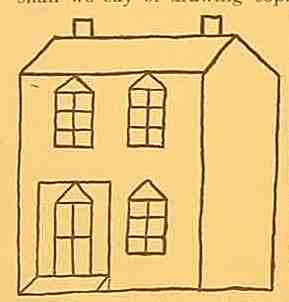 Another feature in the drawings of infants is the difficulty which they experience in grasping the relative proportion of parts. A cup, for instance, which is wider than it is high, will be drawn in converse proportion. Perhaps this is, again, an instance of the error before indicated. Cups are not usually wider than deep, and the child draws, not the cup before him, but the more usual picture which is already established in his mind as a fixed type, and is called up by the hasty view of the particular cup which you show him. Details, again, are exaggerated. The child delights in caricature and in the grotesque, far more than lovers of pure art could wish. I show you a drawing done by a sharp boy of six after nature. The various parts seem to me good, and the face was really like the boy who stood as model. But the proportions are absurd. 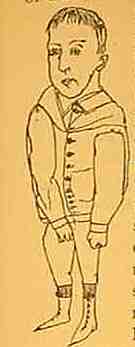 Anyone who has noticed the picture of the Battle San Egidio,* by Paolo Uccello, in the National Gallery, must have noticed with surprise the contrast between the drawing of the horses and of the men. The men in armour are admirably painted, but the horses are quite ridiculous. It seems that it was an innovation in the fourteenth century to paint horses, and competition had not sharpened the artist's powers of observation and execution. The toy-like horses in this picture remind me of children's drawings. Children seem to paint details, and the object is hardly realized as a whole. The child has not learnt to keep two parts in the mind at the same time. One detail is not subordinated to another in the field of vision as it is in nature. A clear instance of the isolation of details in the child's mind, which are really parts of one whole, is well shown in the drawing of an oblong and a square, some space apart, to stand for the two sides of a box seen in perspective. In drawing a head, nearly all beginners make the upper part much too small compared with the lower; they do not allow for brain. So too, the mouth is almost always set too low. * ["With regards the battle depicted within these paintings, famous art historian Giorgio Vasari had studied these works whilst they were displayed at Gualfonda. He documented that they depicted the Battle of San Egidio of 1416 but more recent studies have placed them at the 1432 Battle at San Romano." From paolouccello.net.] Besides the difficulty of holding two, and still more, a number of separate points in the mind at once and duly subordinating one to the other, there is the difficulty caused by attention to that which most attracts attention. A point that specially attracts attention tends to be exaggerated. If, as seems to be the case, the perception of the whole object is one mental act, then the part of the object which absorbs most of the mental activity looms proportionately larger than the rest. But the lessons which we have had in a perception furnish us with another reason why the drawing of beginners is so strangely inexact. In all perception, in every act of perceiving, the law of economy holds. We pay attention, not to all the impressions which we could receive from an object, but only to such a number as may be sufficient to enable us to recognise it. Hence, of the most familiar objects we often have the least detailed images in our minds; and though we should recognise our father sooner than any other man in a crowd, yet we might find it easier to draw a sketch from memory of a striking stranger, once seen, than a memory picture of our father, whom we know so well. Indeed, familiarity, so far from providing us with more exact mental pictures, tends to set up a process of denudation of detail, and to leave in the mind a bare abstraction of the object. Because the child is less self-conscious, he sets down on paper these meagre residues of observations in a way that older persons are ashamed to do, and hence the value of the drawings of children to the student of psychology. The child does not draw the result of his impressions at the moment, but only the abbreviation of them which exists in his mind, and is called up by a glance at the object. What a child draws is really an indication of the contents of his mind in regard to an object, and there is no doubt that the attempt to draw an object, and the subsequent comparison of the drawing with the model, does define and complete the mental image of the object drawn. I will now endeavour to put together a few lessons which may be derived from my study of Infants' Drawing. In the first place, I wish to defend the Kindergarten drawing on square ruled paper. It is, to begin with, a happy and an absorbing occupation; were it no more, it would be valuable for this alone. But it is much more. Children can early learn from it what is the use and meaning of symmetry, and this without technical language. 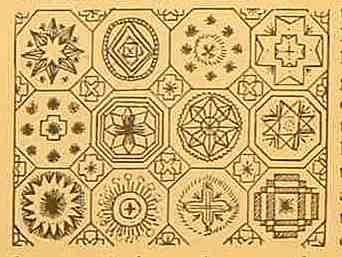 Anyone who has seen what clever geometrical patterns children can draw from their own designs, with a little encouragement of the right sort, will see a valuable introduction through Kindergarten drawing, to weaving and flower gardening and many other crafts. A gardener, for instance, visited the Raw Nook Infant School to see after his child, and was so struck with some of the Kindergarten patterns designed by the infants that he copied them for his own use. "Shall I," said a young woman to the teacher who was beginning to instruct her in weaving--"Shall I find it hard to learn?" "Well," said he, "have you ever learnt to do any Kindergarten work? If so, it is easier for you to learn." The point to remember is that Frobel was much interested in crystallography and its connection with geometrical forms. All Kindergarten drawing which is not founded on geometrical forms is debased, and not according to the idea of the founder. Symmetry is not the same thing as proportion, but is of even greater practical value in every-day life, and is as useful to a girl laying a tea-table as to an architect. I may mention, however, two common errors which children should be taught to avoid. They should mark the beginning and end of each line by a slight dot, and then join them by one swift, firm, light stroke. The mistakes which children make are that they draw from square to square, lengthening their line piece-meal and breaking up one line into little pieces, and they press heavily on the pencil. The just balance of masses is, no doubt, of more consequence in painting than mere symmetrical correctness, but an appreciation of symmetry leads on to an appreciation of harmonious disposition of masses of light and shade. "But," it will be said, "do you recommend curved lines on the square ruled paper? A geometrical curve is wholly different from the artistic line of beauty, or the curve of natural forms, such as the outline of leaves and the curve of their veining." My answer is that the curve of a leaf is indeed different from a geometrical curve, but there is much reason to think that the natural form is, after all, based on the geometrical. The lovely frost forms, for example, which we see in winter on the window-panes, resemble, though with an important difference, the natural forms of leaves. As a rule, the frost foliage is stiff and formal, but when the crystals are formed under certain conditions, the shapes are almost as free flowing as natural forms. I refer the reader to an example of this, which will be found in Nature for December 8th, 1902. Mr. Ruskin, in his "Elements of Drawing," has well pointed out the difference between graceful and ungraceful curvature. He says that a graceful curve approaches in some part of its course to straightness, and that it varies, never remaining equal in degree at different parts of its course. Thus there is a steady change from less to more curvature, or from more to less, but no part of the line is the segment of a circle, and therefore cannot be drawn by compasses. Now, the curves that can be most readily drawn on square ruled paper are doubtless false from an artistic point of view, because they approach to segments of circles; but, on the other hand, by the aid of these squares it is not hard to get quite young children to draw very creditable circles and half-circles, in itself a useful accomplishment, although not for artistic purposes. I have with me some circles about five inches across, which have been drawn by children without mechanical aid. I think, however, that these regular curves may be used as an introduction to the artistic curves of growing and living forms, such as the branches of trees, the veins of leaves or the shape of fruit, like a pear. My reason is as follows:--a number of crystals adhering together, as in frost flowers, present a very regular appearance, no doubt, but if they are separated a little by moisture and acted upon by wind or other force while they are being built together, the resulting form has much of the charm of irregularity and arbitrariness within limits which so please us in living and growing forms. The best way, however, to understand the living form is to study the geometrical form of which it is a more beautiful variation. Leaves and flowers of geometrical curve are false to nature, but if, when such forms have been drawn, they are contrasted with the living and growing forms, which I believe to be modifications of them, the young students may be taught to seize the difference and draw the freer curves after having mastered the more easily drawn geometrical curves. I show you an example of the way in which some teachers make use of geometrical shapes--in this case, a cylinder--to enable children to draw cylindrical objects like trunks of trees, a lighthouse, and a sea anemone. The system is thoroughly carried out in the so-called Prang system, which has been adopted in some American schools. 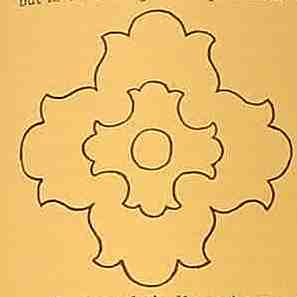 It is my belief that it is of great consequence to establish early in the mind of a child conceptions of symmetry, such as, I think, drawing on square ruled paper leads to. Mr. Symonds affirms that even in Michael Angelo, a want of symmetrical design in his compositions remained with him throughout his life. We have seen how large a share the mind has in combining the impressions which it receives from the outside, and we can understand how important are the early images which a child learns to construct for itself in interpreting impressions. Geometrical patterns, both in curved and straight lines, seem to me the best foundation for this all-important sense of symmetry which helps us in so many duties in daily life. On the other hand, to draw on square ruled paper objects in false perspective is a huge mistake. You are furnishing the young child with false impressions, which he will have the greatest difficulty in unlearning, and which, meanwhile, vitiates his observation of nature in a hundred ways. You make it ten times harder for him to interpret the gift of his senses, and even lead him to mistrust them unfairly, because you have made him misinterpret them by the false form of vision which you have supplied him with. On square ruled paper, only geometrical shapes should be attempted by young children when they commence, and all those modifications of artistic shapes of vases and other graceful objects which have to be reshaped to fit the squares, thereby losing all their grace, should be avoided most scrupulously. There is no connection between the artistic shape and the modified form. As I have said, however, geometrical forms which almost by accident resemble leaves, flowers, or fruit, seem to be more legitimate, because, if they are compared with the living forms, the difference between the two may be readily explained, and the relation of the growing and varying form to the lifeless crystalline shape may be made easy and interesting. Our studies in infants' drawing again seem to indicate that it is a mistake to set young children to copy outline drawings of objects before they have tried to draw the objects themselves or carefully examined them in nature. In the first place, flat copies of objects have this inherent defect, that they shirk the third dimension difficulty. To suppress the difficulty of fore-shortening seems a bad way of helping the child to master it. Secondly, these drawings are sure to prevent the children from forming an independent idea of the object drawn. They will not henceforth see the object with their own eyes, but only with the limited, and often imperfect, vision of another. They will not eye nature, but only a copy of nature. In order to master the use of the pencil, let the children practice geometrical patterns first of all, and not copy drawings of natural forms. As soon as children can use the pencil, it is possible to get them to draw from nature. I think a teacher might place before the child a large water jar, or some piece of pottery, large, bold, and of good shape. She might ask the children to draw the model, and then, by way of correction, instead of correcting the mistakes with a pencil, rather endeavour to point out to the child where he has failed in making a true image in his mind of the real shape of the object. The aim of the teacher should be to help the scholar to use his eyes to a better purpose. If she corrects the child's lines herself, she makes him more lazy in using her eyes, and less attentive to detail and characteristic features. The teacher may build up the shape herself on the blackboard before the children, showing step by step how the eye may be aided to measure the object and the hand to set down the symmetry of the parts truly by use of dots and guiding lines. 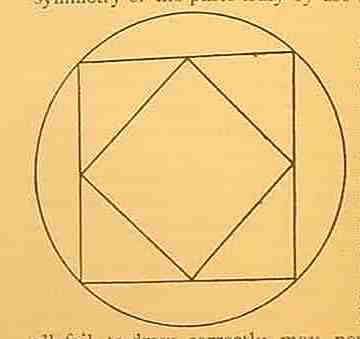 The habit of symetrical drawing on square ruled slates acquired by working out geometrical patterns will greatly assist the child when he afterwards begins to set out points and guiding lines for drawing objects. But in thus drawing an object before the class, the object should itself be exhibited and studied in detail. Many children who after all, fail to draw correctly, may, nevertheless, improve their mental image of the object by aid of the drawing lesson instead of deteriorating it; and art masters who take in hand young persons of sixteen will not find that they have to commence work by teaching their pupils to unlearn. Unsuccessful attempts may, when they fail to produce a work of art, nevertheless increase the blunderer's science by increasing his knowledge of the object. As a variation, I think it is very useful to teach young children to draw by aid of rule and compass. Let them make large circles and then draw diameters crossing at right angles, thus making a frame for a square. They can also draw pentagons and hexagons in the same way--that is, inside circles. They can learn to rule their lines of given length (two, three, four inches, and so forth), and get preliminary notions of measurement. Lastly, I would recommend to the attention of all teachers the valuable letter of Mr. Herkommer's [Rooper later corrected himself and attributed this letter to Sir L. Alma Tadema] in the February number of Hand and Eye, 1893, in which he calls attention to the value of brush drawing. Those who wish children to learn to take in and love the grace of growing forms will realize how much more readily the reproduction of them may be made by the sweep of the brush than by the stroke of the pencil. In all civilized nations, every child is taught to draw. If we ask with what object are they taught drawing, it is important to notice that two answers are possible. A parent who gets instruction in drawing for his child may desire either of two things, or both of them. He may desire his son to become an artist, or he may desire him to be able to draw what he sees--that is, in other words, to become a draughtsman. The two callings may be combined, but are really quite distinct. We have great draughtsmen, like [George Brettingham] Sowerby--who painted objects for works on natural history--whose pictures would be excluded from Burlington House; and we have a great artist like Lady Waterford, whose draughtsmanship was often imperfect. The main use of teaching drawing to ordinary children is to make them draughtsmen rather than artists, and the teaching of drawing should be like all other studies, an aid to the training of the mind. By drawing objects, children should learn to improve, enlarge and define their mental impressions of them, and this they can only do if they are taught by people who are accustomed to observe objects. It is not the aim of parents to make their children into bad artists. Are there as many as ten artists of high rank in a million of the population? An artist satisfies who can give us an harmonious and pleasing arrangement of colour, in a picture which suggests something to our mind. We do not ask for photographic work from an artist, although, indeed, it is true that some pictures at Burlington House do remind us of bits of second-hand photographs enlarged and coloured, but they are not art. The teaching of drawing which we want in schools is largely an education of the eye, and this means a sharpening of the observing powers. The teacher of drawing is a teacher of seeing. An artist's picture may be very pleasing in spite of the fact that a scientific knowledge of the objects painted is conspicuously absent, but we do not wish to teach children to draw pleasing pictures so much as to render, as exactly as their faculties permit them, objects that are really worth prolonged study, and objects of which the accurate knowledge that is obtained by drawing them, strengthens and enlarges the understanding. Proofread by Stephanie H. September, 2008; Proofread by LNL, May 2021  |
| Top | Copyright © 2002-2021 AmblesideOnline. All rights reserved. Use of these resources subject to the terms of our License Agreement. | Home |